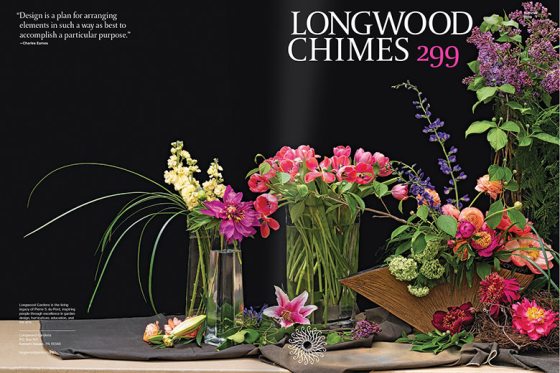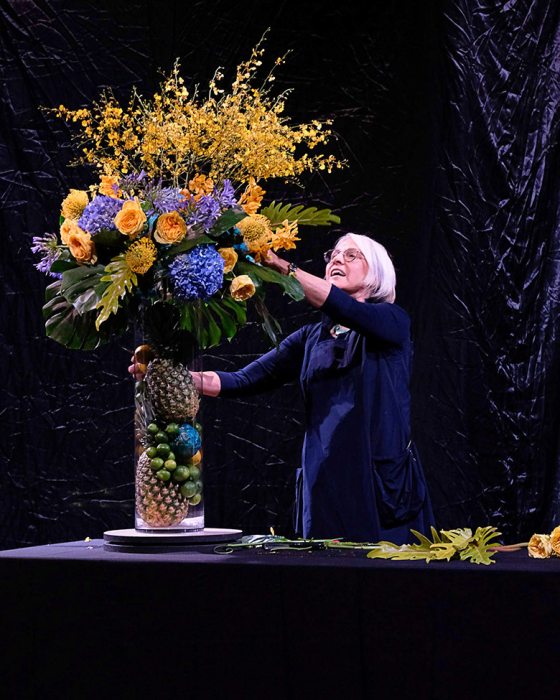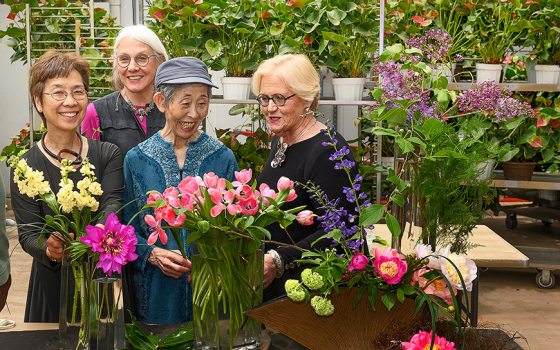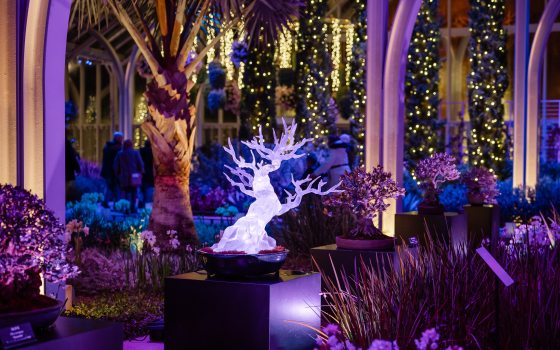This article first appeared in issue 299 of Longwood Chimes, from Summer 2019.
It’s been said that those who can’t do, teach. Here at Longwood, however, the remarkably talented instructors Jane Godshalk, Cres Motzi, Nancy Gingrich Shenk, and Midori Tanimune prove that not only can they do floral design but they can certainly—and quite wonderfully—teach the art of floral design, while inspiring those students lucky enough to learn from them.
Longwood’s floral design program is one of the Northeast’s most respected and forward-thinking, thanks to its diverse courses and lectures, which first began in 1957 with such topics as handling cut flowers, corsage making, and basic principles of flower arrangement.
In the last five years, Longwood has filled 4,600 floral design class seats and, in 2019 alone, is offering 43 floral design classes. Students of the program engage in hands-on instruction, utilizing premier fresh flowers and foliage, while receiving individual attention and guidance from our instructors. Our floral design students can take an individual course or choose to pursue our Certificate of Merit in Floral Design, which requires the completion of a series of challenging, yet inspiring, core courses, electives, and a culminating exam. Since its 1997 start, approximately 400 students have attained the Certificate of Merit in Floral Design—thanks, in large part, to our fantastic floral design instructors.

Godshalk, Motzi, Gingrich Shenk, and Tanimune have garnered international acclaim, earned high-ranking certifications, and realized amazing feats throughout each of their careers. And while they come from very different backgrounds, they all subscribe to one common school of thought—that floral design is meant to be a happy venture. An accessible artform to be shared and enjoyed. And, above all, it’s meant to be fun.

Nancy Gingrich Shenk, for one, definitely knows the rules of floral design. A graduate of Rittner’s Floral School in Boston and the Dutch Masters’ Design School in Holland, and the recipient of a Praktijkdiploma from Stoas College in Holland, Gingrich Shenk (and her resume) are nothing short of dazzling. Among her achievements, she has served as the owner of a custom design studio, a member of the floral design teams for two former presidents’ inaugurations, and the 2008 Teacher of the Year by the North American Colleges and Teachers of Agriculture … and we’ve been fortunate to have her as a Longwood instructor since 1994. In fact, Gingrich Shenk helped develop our Certificate of Merit in Floral Design.
“Floral design is about making something look beautiful,” shares Gingrich Shenk. “As much as I enjoy the rules and teach the rules, here’s what it’s really about: you must learn the rules and then break them. At the end of the day, I just want students to love flowers. I will gladly teach them how to arrange, but the beauty of flowers is when we allow them to speak to us.”
Gingrich Shenk first entered the floral design world at 12 years of age, upon the tragic time of her mother’s passing. “We had so many floral arrangements at the house. My way to deal with it was to stay away from people and focus on the flowers,” shares Gingrich Shenk. “Guests started noticing my care of the flowers, told me I was good at it, and suggested I become a florist. From then on, I never thought of another career choice. I’m one of the few people I know who has stayed in my career my whole life, and I have never once regretted it.”
As much as I enjoy the rules and teach the rules, here’s what it’s really about: you must learn the rules and then break them.
—Nancy Gingrich Shenk, Floral Design Instructor, Longwood Gardens
For Gingrich Shenk, the impact of floral design is profoundly personal and professional. “I have found that so many students come here while recovering from loss or illness. They come to a class and for three hours they don’t have cancer, for one. Or they don’t have sadness. I hear it over and over again … coming to a class here is cheaper than a shrink.” On the professional side, Gingrich Shenk notes her amazement and gratitude as to how many of her students have started their own design studios; she mentors some of those students and hears from many. “We have really helped the horticultural industry as a whole here,” shares Gingrich Shenk. “It’s simply wonderful.”

Two of Gingrich Shenk’s former students are none other than current Longwood instructors Jane Godshalk and Cres Motzi. Motzi’s interest in floral design stems from her mother’s work in the garden while growing up in Hong Kong, before her family moved to New Jersey when Motzi was a teenager. “I had to find my space,” shares Motzi. “But when I think of my childhood, I think of always having plants in the house and my mother gardening.” Motzi took an early interest in floral design, fueled by a few courses and completing floral arrangements for friends. When she and her husband came to Longwood in 2001 to view the Christmas display, her husband picked up a catalog and, after paging through it, noted that Longwood offered a Certificate of Merit in Floral Design. Motzi jumped right in and worked closely with Gingrich Shenk during her studies.
Today, Motzi is a floral designer specializing in western design and Sogetsu Ikebana, as well as a Boerma Instituut in Holland graduate, European Masters Certification recipient, and an American Institute of Floral Designers certified floral evaluator and judge. Motzi has taught at Longwood since 2009. “I come from a family of teachers so my desire to teach has been there a long time,” shares Motzi. “The most rewarding part of teaching is when students walk away with a smile at the end of the class. It’s hugely satisfying. They leave knowing something new and knowing they can do it. There’s huge value in that.”
Contrasting Motzi’s childhood interest in gardening and floral design, Godshalk fell into floral design by accident. “I had earned my master’s in business and organizational behavior, but when I found flowers, everything changed.” Developing an interest in perennials after noticing their beauty in her garden, she came to Longwood to take a course and learn more about them … and the rest is history. After completing her Longwood perennials class and completing her first Garden Club of America flower show arrangement, Godshalk threw herself into the process of learning everything she could about floral design.

Today, Godshalk is an internationally recognized designer known for her fresh American style, a member of the American Institute of Floral Designers and a recipient of the National Medal in Flower Arranging from the Garden Club of America, among many other accolades. Godshalk has been teaching at Longwood for more than a decade; in fact, Gingrich Shenk was one of her first teachers. Godshalk credits the three biggest influences on her career as her Longwood coursework; working with The Garden Club of America; and exhibiting, judging, chairing committees, and working with designers via the Pennsylvania Horticultural Society and the Philadelphia Flower Show.
“Teaching is what I am supposed to do,” shares Godshalk. “I teach that you should not be afraid of making a mistake. One of my students once said this wonderful thing and I say it now too: ‘The difference between a good arrangement and a perfect arrangement is a broken flower.’”
Like Gingrich Shenk, Motzi, and Godshalk, instructor Midori Tanimune is a true force, but with her trademark gentle spirit and approach beloved by her colleagues and students. A Japan native, Tanimune has attained the Komon degree, only one step below the top rank of Sogetsu Ikebana artists, and is held in high regard throughout the international Ikebana community. While Tanimune’s approach to floral design and style is vastly different than that of Gingrich Shenk, their origins in floral design are remarkably, and tragically, similar. Tanimune lost her father when she was 11 years old. Before his passing, she and her father would walk together every night after dinner to their vegetable garden. Her father would talk to her about gardening, teach her to look at the elements around them, and especially notice the sky above. “After my father died, I didn’t know what to do. I was lost. My mother ended up saving me when she found my Ikebana school and enrolled me in it. I would go there to not only learn, but to talk to my teacher, who would listen to my sadness and help me express it. Ikebana was a way to fuel my sorrow,” Tanimune shares.
Tanimune found her way again through the practice of Sogetsu Ikebana, even forming an Ikebana club in high school to talk with her classmates about flowers, trees, and design. When she and her husband moved to America in 1968, they had “nothing but a working visa.” But building upon her talents and her passion for floral design, Tanimune found herself working with florists and then teaching design. She has now been teaching at Longwood for nearly 20 years. When it comes to teaching, Tanimune’s goal is to “spread my passion to as many people as possible. I want to share the beauty of Ikebana. It’s a meditation. With it, you must be happy. Be thoughtful. Be calm. Make time for yourself while working on the material and only talk to the material. Let the busy part of life disappear.”
To Tanimune, the art of floral design is both deeply personal and universal. “I like to make people happy when looking at an arrangement of mine,” she shares. I want them to see my soul through it. It’s a very beautiful way to make people think deeper about what beauty really is.” We are grateful to have learned so much from all of them.


